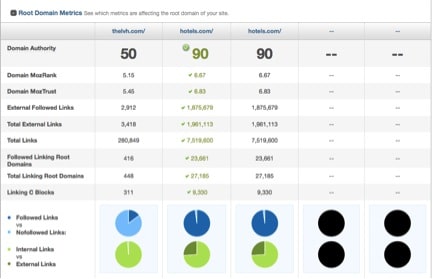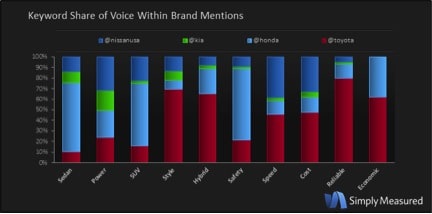Take my personalized result here in Duluth for the query Las Vegas Hotel. Note my top three organic winners, LVH, expedia and hotels.com.

 It’s fascinating to graze through the three panels of moz Open Site Explorer below in relation to my personalized results. Search for it yourself. Take note of your results. Study link and social variables that may contribute to your SERPs. Certainly, competitive link metrics amount to a share of voice.
It’s fascinating to graze through the three panels of moz Open Site Explorer below in relation to my personalized results. Search for it yourself. Take note of your results. Study link and social variables that may contribute to your SERPs. Certainly, competitive link metrics amount to a share of voice.



Let’s move from SEO now and focus on social share of voice. Then we’ll pivot to Boolean queries and holistic SOV.
 Social share of voice is hardly a standard metrics suite agreed upon by all social media professionals. That said, the traditional understanding of social SOV is about measuring the trended frequency of conversations about your brand versus your competitors/market. In other words, social SOV comes to mean measuring the raw quantity of chatter. People chirping about your brand may be positive, negative or neutral. When most marketers are inquiring as to social share of voice, this trended chatter volume has been what matters. This approach is somewhat antiquated. Read on and we’ll show you why.
Social share of voice is hardly a standard metrics suite agreed upon by all social media professionals. That said, the traditional understanding of social SOV is about measuring the trended frequency of conversations about your brand versus your competitors/market. In other words, social SOV comes to mean measuring the raw quantity of chatter. People chirping about your brand may be positive, negative or neutral. When most marketers are inquiring as to social share of voice, this trended chatter volume has been what matters. This approach is somewhat antiquated. Read on and we’ll show you why.

Unless the social analytics tool you fancy measures competitors as well, it’s not an SOV tool. That said, if you’re willing to pull publicly available data on competitors and handle the comparison calculations yourself, you can turn many social analytics tools into your own SOV reports.
There are precious few share of voice measurement tools for insight into individual social channels. Check out the Twitter keyword SOV within brand mentions tool from SimplyMeasured. It’s interesting because the front end query gets beyond 1 dimensional relative-chatter measurements. This bar graph measures keyword mentions proportionally between competitors. Simply mentioned does this easily from public data, filtering from the Twitter API data hose.


Continue Reading:









